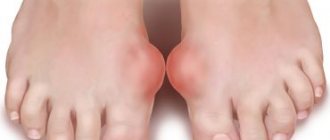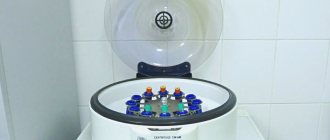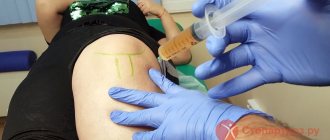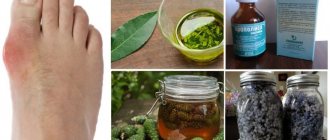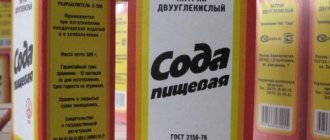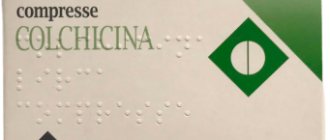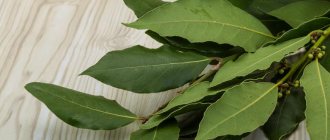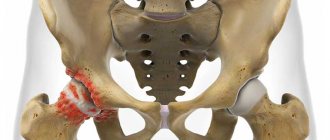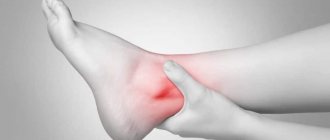Gout
Gout is a disease consisting of a disorder of uric acid metabolism. Gout is usually classified as a joint disease because excess uric acid forms salts (urates), which are deposited primarily in the joints. The first joint affected is the joint of the big toe. An inflamed bump on the thumb is a characteristic symptom of gout.
Genetically, men are more predisposed to this disease. Among the sick, almost 95% of them are. The peak incidence in men occurs at the age of 40-50 years, in women – from 60 years and older. However, gout can also affect people at a younger age.
Causes of gout
Any product of biological origin contains purines - substances that are building materials for RNA and DNA. Purine bases ingested in food are broken down, resulting in the formation of uric acid. This is a normal process. Uric acid is present in body tissues and blood plasma. The blood carries uric acid to the kidneys, where it is filtered and excreted in urine. Part of the uric acid (1/3) is excreted through the intestines. If this normal metabolism is disrupted, uric acid begins to accumulate in excess amounts.
Violations of purine metabolism can be caused by:
- genetically determined fermentopathy
. Gout develops if the production of enzymes responsible for converting purine bases into uric acid and removing the latter from the body deviates from the norm (deficiency of some enzymes is critical, hyperfunction of others). This disorder is largely due to DNA damage. The site responsible for these enzymes is located on the X chromosome. Men have one X chromosome, and women have two. This is why men are more likely to suffer from gout (women have, so to speak, a “backup copy” of the necessary genes);
- increased consumption of purine bases
. In ancient times, gout was called the “disease of kings.” The kings ate the best food, and could eat the meat of young animals, deli meats and cream pies unlimitedly (and these products are leaders in purine content. There are also a lot of purines in fatty fish, meat and fish broths, and legumes). In itself, an excess of purines in food is not dangerous, since normally the kidneys cope with the entire volume of uric acid produced. However, if there is a genetic pathology or kidney problems, gout becomes very likely;
- violation of the excretion of uric acid from the body
. If you have kidney disease, uric acid filtration may decrease. Less of it will be excreted, and its concentration in the blood will increase;
- increased catabolism of the body's own purine compounds
. Man is part of the biological world, and our body is built according to general laws. RNA and DNA are present in our body - in every cell, which means they have their own purine bases. Increased cell destruction (or otherwise catabolism - the breakdown of complex compounds into simpler ones) leads to the same increase in uric acid in the blood as if we began to receive an excess amount of purines from the outside. The reasons for the increased catabolism of purine compounds in one's own body may be radiotherapy or chemotherapy, taking certain medications, hemolysis (decomposition of red blood cells, which is caused by severe infectious diseases or diseases of the hematopoietic system).
How to treat gouty arthritis
Being, in fact, one of the chronic arthritis, gout is treatable much better than other joint diseases. Although a complete cure is not possible, metabolic disorders can be controlled through medication, physical therapy and diet.
The treatment regimen is determined individually. It may include measures to relieve exacerbations and pain attacks, prevent relapse, and eliminate discomfort from a chronic disease
If a patient's gouty arthritis does not have a genetic etiology and is not associated with other chronic diseases, its course depends entirely on the patient's compliance with the therapeutic regimen, in particular, a diet with a reduced purine content.
Regular monitoring of uric acid levels and a course of enterosorbents are also recommended. Gout is not treated surgically, however, if the tophi grows excessively, a minor operation may be performed for the patient’s convenience.
Clinical recommendations for gouty arthritis necessarily include losing excess weight.
Treatment of gouty arthritis with medications
A comprehensive treatment regimen for gouty arthritis with medications includes anti-inflammatory drugs (steroidal or non-steroidal, depending on the condition), uricodepressive, uricosuric and uricolytic drugs. After the inflammation is relieved, the primary goal of therapy is to stimulate the excretory function of the kidneys, due to which the level of uric acid in the patient’s body decreases.
Physiotherapy in the treatment of gout
Physiotherapeutic techniques for the treatment of gouty arthritis are primarily aimed at alleviating pain symptoms and stimulating metabolic processes in tissues. The best effect is demonstrated by:
- high-frequency magnetic therapy;
- UV irradiation in erythemal doses;
- Low intensity UHF therapy;
- centimeter wave therapy;
- DMV therapy for the adrenal glands.
If the mentioned types of therapy are contraindicated for the patient, treatment with leeches is possible.
Diet for gouty arthritis
Diet plays a leading role in discussions about how to treat gouty arthritis. To keep the symptoms of gouty arthritis under control, it is essential to follow a low-carbohydrate diet with minimal purine levels. And although these compounds are found in all foods without exception, it is important to exclude their main sources:
- meat, fish and other broths;
- offal, lard;
- canned food;
- tomatoes, potatoes and other nightshade plants;
- legumes (especially beans, peas, lentils).
Consumption of meat and fish should be reduced as much as possible. Milk and fermented milk products and eggs are used as sources of protein in the anti-gout diet. It is recommended to minimize the consumption of chocolate, mushrooms, and fructose.
Everything fried is also prohibited. Preference should be given to dishes prepared by steaming, stewing or boiling. Alcohol must be completely avoided; it not only causes hyperproduction of urate, but also reduces the effectiveness of drug treatment for gouty arthritis. Remember that alcohol is one of the main “provocateurs” of exacerbation.
Under no circumstances should you go hungry. Fluid intake (from 2 liters per day) should include mineral and purified water, green tea, unsweetened fruit drinks to prevent uric acid kidney stones.
Following a diet helps to significantly reduce the patient’s need to treat gouty arthritis with medications.
Gout symptoms
An attack of gout is manifested by acute pain in the affected joint
The first stage of gout is described as hyperuricemia (increased uric acid in the blood). Hyperuricemia is detected using a biochemical blood test. In most cases, no other symptoms of the disease are detected. Sometimes general weakness, sweating, itchy skin, and constipation may occur.
Actually, it is worth talking about gout from the moment of the onset of acute gout attacks. An attack of gouty arthritis can be triggered by:
- drinking alcohol (single consumption of a significant dose);
- hypothermia;
- joint injury;
- common acute respiratory infections.
First of all, as a rule, the joint of the big toe (first metatarsophalangeal joint) is affected. Typically the joint is affected in only one leg. Quite often other small joints are affected - the wrist or phalanges of the fingers. In the future, other joints may suffer from gout attacks. In women, the disease can affect several joints at once at the very beginning.
Typically, an attack of gouty arthritis lasts no more than 5-7 days, after which complete remission occurs (all symptoms disappear) - until the next attack. This course of gout is called the intermittent (“interval”) stage. Then the disease can progress to the chronic stage.
Attack of gouty arthritis
An attack of gouty arthritis is manifested by acute pain in the joint. Quite quickly, the area of the affected joint swells and turns red. The color of the skin over the joint may take on a bluish tint. The patient feels chills and the temperature rises, possibly up to 38 °C or higher. Any touch to the joint increases the pain, the joint completely loses mobility. The pain can be very intense and cannot be relieved by analgesics.
In most cases, the attack occurs at night; by morning the pain usually subsides. However, in severe cases, severe pain can last up to 3 days, then its intensity slowly decreases.
Chronic gout
If attacks of gouty arthritis become frequent and are quite severe (periods of pain prevail over periods of remission), chronic gout is diagnosed. The chronic form of the disease is characterized by increased dysfunction of the affected joints, and as the patient stops using them, atrophy of the articular muscles develops.
A specific symptom of gout is the formation of tophi. Tophus is a subcutaneous or intradermal accumulation of urates (uric acid salts). Tophi look like nodules - dense, rounded formations. Their diameter can vary from 2 mm to 5 cm or more. Tophi usually appear approximately 5 years after the first attack of gout, slowly increasing in size. However, with an unfavorable course, their formation can occur more quickly. Typical places where they occur are fingers and toes, ears, knee and elbow joints, feet, and brow ridges. It doesn't hurt to touch these formations. The skin over tophi is usually dry and rough because its blood supply is impaired. Over time, a fistula may form in this place, through which a white pasty mass (urate itself) is released.
Tophi are not always formed (only in 50-60% of patients).
Chronic gout also often causes urolithiasis. Urates can form kidney stones, which can cause renal colic, block the outflow of urine, and contribute to the development of pyelonephritis.
Why does smoking worsen gout?
Nicotine has a negative effect on bone strength. Their tissues are formed by three types of cells: osteoclasts, osteocytes and osteoblasts. As a result of smoking, the latter die, which provokes bone fragility and causes them to lose strength.
Cigarette smoke contains toxins that disrupt the smoker's hormonal levels. The cortisone hormone increases, which can cause osteoporosis and, as a result, joint pain. The body of a person who smokes regularly for a long time gradually loses the ability to absorb calcium, which also negatively affects the strength of bone tissue.
Numerous studies have proven a direct connection between bad habits and osteochondrosis. In this case, the intervertebral discs wear out faster because they do not have time to receive enough nutrition. Another problem can be caused by a lack of oxygen in the tissues. Combining with carbon monoxide, hemoglobin, which is responsible for transportation, cannot carry oxygen to the tissues. As a result, the smoker's bone structure becomes more susceptible to injury and pathology.
If we talk only about joints, then bone and cartilage tissue first suffers from smoking. The reason lies in the lack of cells involved in the formation of new tissues. The joint is primarily nourished by the synovial fluid located in the joint cavities, but due to regular cigarette poisoning, its composition changes qualitatively. The synovial fluid becomes more viscous and loses nutrients, which is necessary for the normal level of cartilage strength and elasticity. As a result, the cartilage dries out, gradually cracks and collapses.
Methods for diagnosing gout
Diagnosis of gout includes physical, laboratory and instrumental research methods. The diagnosis of gout is made when several signs characteristic of this disease coincide
Physical diagnosis
Physical diagnosis involves visual examination of the patient and palpation. The examination results are compared with the patient’s complaints and medical history.
Laboratory diagnostics
Laboratory diagnostics make it possible to establish that the cause of pathological changes in the joint is a violation of uric acid metabolism. The following analyzes play a decisive role in this:
- biochemical blood test (the level of uric acid in the blood plasma is important);
- analysis of synovial (intraarticular) fluid for the presence of urates in it. To do this, a puncture of the joint is done.
- 24-hour urine collection can be performed to assess glomerular filtration rate.
If there is a need to confirm that the detected tumors in the joint are tophi, a biopsy is performed with further examination of their contents.
Instrumental diagnostics
X-rays can reveal pathological changes in the joints. They occur in late stages, so the onset of the disease cannot be determined using x-ray methods. To identify tophi (they do not always protrude above the surface of the skin), computed tomography or MRI are used.
In the early stages, ultrasound can be used. Using ultrasound, fairly small deposits of salts are detected, so tophi are visible on ultrasound even at the stage of their formation. Also a characteristic sign of gout is a “double contour” - the appearance of an echogenic strip running parallel to the line of the articular cartilage. It occurs because salt crystals do not penetrate the structure of the cartilage, but simply cover it on top, creating a duplicate contour that is clearly visible during examination.
Sign up for diagnostics To accurately diagnose the disease, make an appointment with specialists from the Family Doctor network.
Treatment methods for gout
Treatment for gout is aimed at:
- in case of an acute attack - to relieve it;
- in the remission stage - to normalize uric acid metabolism. Of course, one should strive to eliminate the cause of the disease. However, if the cause of gout is fermentopathy, this is impossible. In this case, treatment will be symptomatic.
- for the treatment of concomitant diseases.
A complete cure for gout is impossible. However, with medical help, it is possible to reduce the frequency of attacks and achieve a significant increase in periods of remission.
Which doctor treats gout?
For treatment of gout, you should consult a rheumatologist. The help of an orthopedic doctor may be required (for example, if surgery is necessary).
Treatment of an acute attack
First of all, the patient needs rest. The inflamed joint should be immobilized. It is recommended to apply cold. You need to drink plenty of alkaline fluids - up to 3 liters per day. It is important to follow a diet: foods high in purine bases should be excluded. Painkillers (NSAIDs) and glucocorticoids are used as prescribed by a doctor. Local treatment is carried out using ointments and gels that have anti-inflammatory and analgesic effects.
When the patient feels better, physical therapy is included in the treatment. Electrophoresis, UV irradiation, and UHF are used.
Treatment of gout in remission
Treatment in remission includes:
- lifestyle changes (primarily giving up alcohol);
- diet (exclude foods that contain a lot of purines - fish, mushrooms, legumes). The diet must be prescribed by a doctor;
- drug therapy (anti-gout drugs);
- local treatment - applications of medications, physiotherapy, massage, medicinal baths (in sanatoriums);
- surgical treatment: removal of tophi that are not amenable to conservative treatment, surgical restoration of affected joints.
Make an appointment Do not self-medicate. Contact our specialists who will correctly diagnose and prescribe treatment.
Rate how useful the material was
thank you for rating
How to quit smoking
To successfully quit smoking and never return to this harmful habit, you must first make a clear decision to take such a step and understand why exactly this is needed. The smoker himself must want to stop picking up smoking sticks, since most often insistent relatives or other external factors help little. It is recommended to follow these tips:
- Decide. You should consciously come to the conclusion that you need to quit smoking. Some people prefer to give up the habit gradually, reducing the number of cigarettes smoked daily, increasing the distance between “approaches,” or not finishing each subsequent cigarette to the end. But, as statistics show, a lightning-fast solution works best when the smoker does not wait for Monday or the beginning of the month, but stops smoking on the day when such a thought came to him.
- Eliminate triggers from your life. Usually smokers have something that provokes them to take out and light a cigarette on a subconscious level. These can be places (balcony at home, smoking room at work, etc.), people (colleagues, friends, meetings with whom are always accompanied by smoking), time of day (after waking up, lunch break, before bed), activities (morning coffee, conversations by phone), etc. It is recommended to write down exactly what triggers prompt you to light a cigarette, and analyze what acts more strongly than others. The most powerful triggers can be eliminated from your life in the first weeks of quitting a bad habit.
- Replace with useful activities and sports. It is recommended to occupy the freed time with other, more important and interesting things: do a few squats, take a walk, read a book, sort out the accumulated clutter on your desktop, etc.
- You can tell your friends and family about your decision; you can share the information on your social networks. This will be an excellent motivator; in difficult moments it will not allow you to leave the intended route.
- Eat more vegetables. Scientists say that the human brain often confuses a craving for fiber with a craving for tobacco.
- Drink milk, as it spoils the cigarette taste, exclude coffee, alcohol and meat, which, as scientists from the USA have found, improve it.
- Seek help from a specialist.
